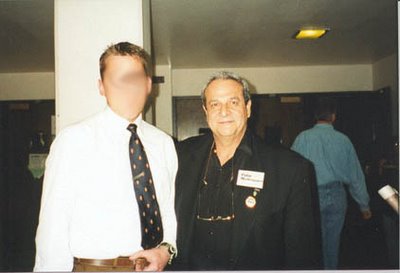 Felix Rodriguez of the Central Intelligence Agency - The Great Che Hunter.
Felix Rodriguez of the Central Intelligence Agency - The Great Che Hunter.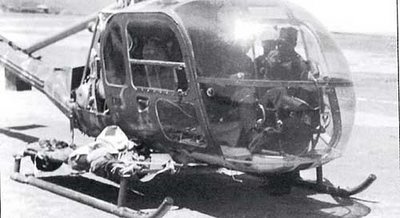
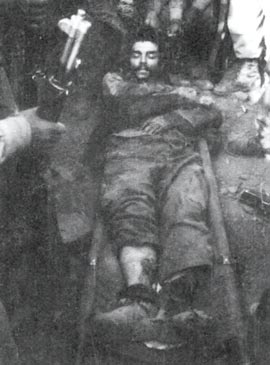
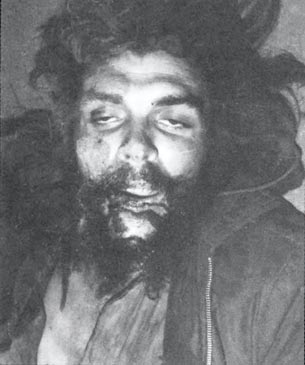
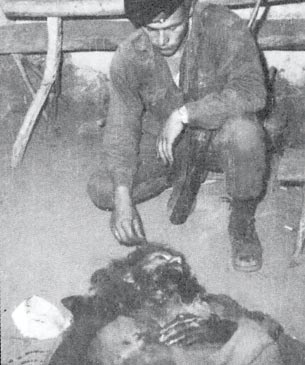
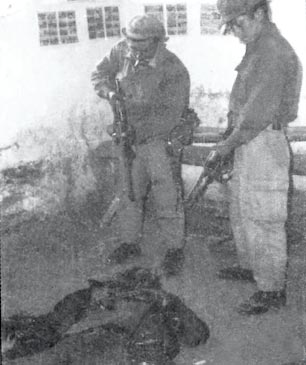
 The last picture of Che taken while alive, "I felt sorry for him."
The last picture of Che taken while alive, "I felt sorry for him."Electronic Briefing Book No. 5
The Death of Che Guevara: Declassified
by Peter Kornbluh
OCTOBER 9, 1967: 6:15 a.m.: Félix Rodríguez arrives by helicopter in La Higuera, along with Colonel Joaquín Zenteno Anaya. Rodríguez brings a powerful portable field radio and a camera with a special four-footed stand used to photograph documents. He quietly observes the scene in the schoolhouse, and records what he sees, finding the situation "gruesome" with Che lying in dirt, his arms tied behind his back and his feet bound together, next to the bodies of his friends. He looks "like a piece of trash" with matted hair, torn clothes, and wearing only pieces of leather on his feet for shoes. In one interview, Rodríguez states that, " I had mixed emotions when I first arrived there. Here was the man who had assassinated many of my countrymen. And nevertheless, when I saw him, the way he looked....I felt really sorry for him." (Rodríguez:2)
Rodríguez sets up his radio and transmits a coded message to the CIA station in either Peru or Brazil to be retransmitted to Langley headquarters. Rodríguez also starts to photograph Che’s diary and other captured documents. Later, Rodríguez spends time talking with Che and takes a picture with him. The photos that Rodríguez takes are preserved by the CIA. (Anderson, 793; Rodríguez:1, 193)
10 am: The Bolivian officers are faced with the question of what to do with Che. The possibility of prosecuting him is ruled out because a trial would focus world attention on him and could generate sympathetic propaganda for Che and for Cuba. It is concluded that Che must be executed immediately, but it is agreed upon that the official story will be that he died from wounds received in battle. Félix Rodríguez receives a call from Vallegrande and is ordered by the Superior Command to conduct Operation Five Hundred and Six Hundred. Five hundred is the Bolivian code for Che and six hundred is the order to kill him. Rodríguez informs Colonel Zenteno of the order, but also tells him that the U.S. government has instructed him to keep Che alive at all costs. The CIA and the U.S. government have arranged helicopters and airplanes to take Che to Panama for interrogation. However, Colonel Zenteno says he must obey his own orders and Rodríguez decides, "to let history take its course," and to leave the matter in the hands of the Bolivians. (Anderson, 795; Harris 128, 129; Rodríguez:1, 193; Rodríguez:2)
Rodríguez realizes that he cannot stall any longer when a school teacher informs him that she has heard a news report on Che’s death on her radio. Rodríguez enters the schoolhouse to tell Che of the orders from the Bolivian high command. Che understands and says, "It is better like this ... I never should have been captured alive." Che gives Rodríguez a message for his wife and for Fidel, they embrace and Rodríguez leaves the room. (Rodríguez:2; Anderson, 796)
According to one source, the top ranking officers in La Higuera instruct the noncommissioned officers to carry out the order and straws are drawn to determine who will execute Che. Just before noon, having drawn the shortest straw, Sergeant Jaime Terán goes to the schoolhouse to execute Che. Terán finds Che propped up against the wall and Che asks him to wait a moment until he stands up. Terán is frightened, runs away and is ordered back by Colonel Selich and Colonel Zenteno. "Still trembling" he returns to the schoolhouse and without looking at Che’s face he fires into his chest and side. Several soldiers, also wanting to shoot Che, enter the room and shoot him. (Harris, 129)
Félix Rodríguez has stated that, "I told the Sargento to shoot....and I understand that he borrowed an M-2 carbine from a Lt. Pérez who was in the area." Rodríguez places the time of the shooting at 1:10 p.m. Bolivian time. (Rodríguez:2)
In Jon Lee Anderson’s account, Sergeant Terán volunteers to shoot Che. Che's last words, which are addressed to Terán, are "I know you've come to kill me. Shoot, you are only going to kill a man." Terán shoots Che in the arms and legs and then in Che's thorax, filling his lungs with blood. (Anderson, 796)
OCTOBER 9, 1967: Early in the morning, the unit receives the order to execute Guevara and the other prisoners. Lt. Pérez asks Guevara if he wishes anything before his execution. Guevara replies that he only wishes to "die with a full stomach." Pérez asks him if he is a "materialist" and Guevara answers only "perhaps." When Sgt. Terán (the executioner) enters the room, Guevara stands up with his hands tied and states, "I know what you have come for I am ready." Terán tells him to be seated and leaves the room for a few moments. While Terán was outside, Sgt. Huacka enters another small house, where "Willy" was being held, and shoots him. When Terán comes back, Guevara stands up and refuses to be seated saying: "I will remain standing for this." Terán gets angry and tells Guevara to be seated again. Finally, Guevara tells him: "Know this now, you are killing a man." Terán fires his M2 Carbine and kills him. (Dept. of Defense Intelligence Information Report - 11/28/67).
Later that afternoon: Senior army officers and CIA Agent, Félix Rodríguez, leave La Higuera by helicopter for army headquarters in Vallegrande. Upon landing, Rodríguez quickly leaves the helicopter knowing that Castro’s people will be there looking for CIA agents. Pulling a Bolivian army cap over his face, he is not noticed by anyone. (Rodríguez:1, 12; Harris, 130)
Che’s body is flown to Vallegrande by helicopter and later fingerprinted and embalmed. (NYT 10/11/67)
General Ovando, Chief of Bolivian Armed Forces, states that just before he died, Che said, "I am Che Guevara and I have failed." (James, 8)
OCTOBER 10, 1967: W.G. Bowdler sends a note to Walt Rostow saying that they do not know if Che Guevara was "among the casualties of the October 8 engagement." They think that there are no guerrilla survivors. By October 9, they thought two guerrilla were wounded and possibly one of them is Che. (Bowdler, The White House 10/10/67)
OCTOBER 10, 1967: Two doctors,. Moisés Abraham Baptista and José Martínez Cazo, at the Hospital Knights of Malta, Vallegrande, Bolivia, sign a death certificate for Che Guevara. The document states that "on October 9 at 5:30 p.m., there arrived...Ernesto Guevara Lynch, approximately 40 years of age, the cause of death being multiple bullet wounds in the thorax and extremities. Preservative was applied to the body." On the same day, and autopsy report records the multiple bullets wounds found in Guevara’s body. "The cause of death," states the autopsy report, "was the thorax wounds and consequent hemorrhaging." (U.S. Embassy in La Paz, Bolivia, Airgram, 10/18/67)
OCTOBER 10, 1967: General Ovando announces that Che died the day before at 1:30 p.m. This means that Che lived for twenty-two hours after the battle in Quebrada del Yuro, which contradicts Colonel Zenteno’s story. Colonel Zenteno changes his story to support General Ovando’s. (James, 15)
The New York Times reports that the Bolivian Army High Command dispatches officially confirm that Che was killed in the battle on Sunday October 8th. General Ovando states that Che admitted his identity and the failure of his guerrilla campaign before dying of his wounds. (NYT 10/10/67)
Ernesto Guevara, the father of Che, denies the death of his son, stating that there is no evidence to prove the killing. (NYT 10/11/67)
OCTOBER 11, 1967: General Ovando claims that on this day Che’s body is buried in the Vallegrande area. (James, 19)
OCTOBER 11, 1967: President Lyndon Johnson receives a memorandum from Walt W. Rostow: "This morning we are about 99% sure that "Che" Guevara is dead." The memo informs the President that according to the CIA, Che was taken alive and after a short interrogation General Ovando ordered his execution. (Rostow, "Death of Che Guevara," 10/11/67)
OCTOBER 11, 1967: Walt Rostow sends a memorandum to the President stating that they "are 99% sure that ‘Che’ Guevara is dead." He explains that Guevara’s death carries significant implications: "It marks the passing of another of the aggressive, romantic revolutionaries...In the Latin American context, it will have a strong impact in discouraging would -be guerrillas. It shows the soundness of our ‘preventive medicine’ assistance to countries facing incipient insurgency--it was the Bolivian 2nd Ranger Battalion, trained by our Green Berets from June-September of this year, that cornered him and got him." (Rostow 10/11/67)

No comments:
Post a Comment